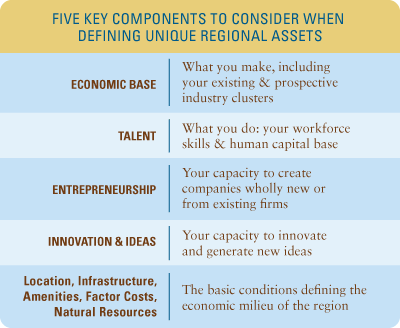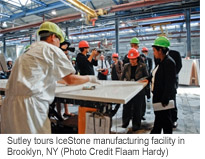Q&A with Matthew Chase, Executive Director, National Association of Development Organizations

Matthew Chase has served as the Executive Director of the National Association of Development Organizations (NADO) and the NADO Research Foundation since October 2003. Chase has extensive advocacy experience with federal, community, economic, and rural development programs, including successful campaigns to reauthorize the Economic Development Administration (EDA) in 1998 and 2004, establish the Delta Regional Authority in the early 2000s, and preserve annual funding for core rural development programs under USDA.
Q: As an organization, in what ways is the National Association of Development Organizations (NADO) strengthening the economic competitiveness of America's regions?
A: NADO focuses on promoting federal community and economic development policies that strengthen local governments, communities, and economies through regional solutions, partnerships, and strategies. Our main goal is to build stronger regional development organizations, including EDA's national network of 383 Economic Development Districts, through peer learning, broader implementation and sharing of noteworthy practices, and development of sound public policy.
Q: Are there specific Obama Administration initiatives that have impacted the work of the regional development organizations NADO represents?
A: Our members are excited about several administration priorities, including the new White House Council on Rural America and the President's emphasis on export trade and regional innovation. Our members agree that we need to address the fundamental building blocks for underserved and distressed areas, while also pursuing new areas of opportunity for economic growth. We share a common goal of building more resilient communities and a stronger employment base across the nation. As an organization focused on regional development, especially through partnerships with local government officials, we are pleased with the Obama administration's support for regional strategies and sustainable development.
Q: How is NADO promoting regional strategies that help to create job and economic growth?
A: NADO is working with our national membership to examine successful and emerging regional innovation models, including strategies to keep wealth and ownership locally. We are working with EDA and other federal officials to improve the coordination of federal resources and investments, including through EDA's Comprehensive Economic Development Strategy (CEDS) process. Most importantly, we remain committed to working with our members and partners to ensure America's local communities have the public assets required to sustain competitive private businesses: modern infrastructure (including broadband), talented workforce, access to affordable capital and quality of place.
Q: Discuss tools and resources that support local efforts to jumpstart economic ecosystems.
A: As noted during the EDA Know Your Region webinar series this year, regional collaboration among public, private and nonprofit sector leaders is essential in today's world. We need a convergence of ideas and skill sets across and within regions. This takes trust, leadership, and vision. One proven way to build this framework for collaboration is through sound data and information, including a mapping of regional assets, innovation, and institutional relationships. In today's tough budget environment, we need to be leveraging and coordinating public resources with private, nonprofit, and philanthropic investments. Most importantly, regions need to take a hard, honest look at their competitive advantages, including opportunities for export development.
We're exploring some creative models and partnerships around the nation, including partnerships between EDA's university centers and the Economic Development Districts. Kansas State University's Advancement Manufacturing Institute and the state's EDDs are piloting some great new work on regional innovation clusters in rural settings. EDDs in northern and eastern Maine are working hard to align their regional Workforce Investment Boards with their EDDs
.
How Innovation and Entrepreneurship are framing the New Economy
News of the activities of large American firms during the current era of economy recovery has communicated stark realties to everyone from policymakers in Washington to many Americans searching for better employment opportunities. A recent Commerce Department report shows that American companies laid off 2.9 million workers, while increasing employment overseas by 2.4 million. A prime example is that of General Electric. In a recent spotlight, it was revealed that nearly half of its workforce is located overseas and this ostensibly American firm is contributing much less than what was perceived to the tax base of the U.S. The Kauffman Foundation's Research Series on Firm Formation and Economic Growth indicated that for all but seven years between 1977 and 2005, existing firms have been net job destroyers, losing 1 million net jobs per year. By contrast, in their first year, new firms add an average of 3 million jobs, according to this study.

However, these developments were not news to many of our fellow practitioners in the Economic Development community.
For several years, our emphasis has been directed to supporting the growth of new high-tech firms and start-ups. As economic development practitioners, we are experienced in working with the strategic legacy industries in our geography, whether that legacy is in agriculture, manufacturing, shipping and logistics, scientific, or engineering. New firms in our regions benefit from interaction with like-minded people with similar industry background, not to mention the ability to integrate into existing supply-chains much faster.
To the credit and leadership of the Economic Development Administration, it has linked its funding allocation to articulated strategies that link key economic assets within cities and regions. These assets are many interrelating components including your capacity to innovate and generate new ideas incorporating academic and laboratory research, the area's existing and prospective industry composition, critical mass of workforce talent and skills, entrepreneurial capacity to create new companies and other geographic considerations whether natural or man-made. Industry cluster analysis is one lens and tool to consider the composition of our regions. We do not all have clusters based on the way they are defined and characterized in modern cluster theory, but we all have unique economic assets, strategic industries or innovative niches that are critical to mobilize regional innovation.
Still, in today’s knowledge-economy, where value is derived from creating, evaluating, and trading knowledge, the primary unit of emphasis and driver of economic growth is supporting our small and medium-sized enterprises (SMEs) and the entrepreneur who is the risk-taker at the center of the company. SME’s generate over 60 percent of net new jobs annually, employ 30 percent of high-tech, scientists, engineers, and information technology workers, and produce 13 to 14 percent more patents per employee than larger firms. Small firms are the true drivers of innovation in the U.S. In many examples, these firms embody the confluence in the application of technological advancement, the transformation of markets, financial risk-taking, and people enabling the transfer of knowledge and creation of wealth.
In supporting and accelerating the creation of SME’s, there remains much to do for practitioners and programs in the economic development community. In April, the U.S. private sector created 244,000 jobs. At this rate, it’s going to take seven years to get to full-employment. Another great concern is the growing wealth of large firms in reverse proportion to their number of employees.
This scenario only fuels our required focus on the support of innovation, entrepreneurs, and SME’s. Logically, the EDA has incorporated the support of innovation and regional innovation ecosystem that enable improved economic development organizations, that I refer to as “Innovation Intermediaries” to support the growth of local SME’s and provide a multitude of other key functions of innovation connectivity. And by innovation, it is not just defined only through the building of new products; it is the creation and transformation of knowledge and new processes and services that meet a market need, in addition to new products. It’s about new ways to partner, innovative interactions, entertainment forms, ways of communicating and collaborating. Innovation truly distinguishes the leaders in today’s economy.
For several years, our emphasis has been directed to supporting the growth of new high-tech firms and start-ups that are driven by advances in biomedical research, clean energy technology, better and stronger new materials, miniaturization of electronics and nanotechnology, and faster computing capabilities. As economic development practitioners, we have all worked on nurturing these advancements to research and technology with the goal of creating amenable environments for innovators and entrepreneurs so these people are grown, retained, and attracted by our local geographies.
It is time to review how far we have come with a focus on improving technologies and transcend that focus to technological innovation. To this end, the EDA can only strengthen its leadership.
EDA is in a position to lead the full paradigm shift to promoting Innovation Based Economic Development (IBED) through fostering the growth of regional innovation ecosystems that support and enable entrepreneurs and SMEs. Small businesses are the innovation-adopters around the globe, where large firms tend to be the innovation-blockers with in-house legal teams operating to protect precious market share. EDA must continue to strengthen its tools, instruments of innovation, resources, and finances to support the practitioners of IBED that support and accelerate the growth of SMEs, because the U.S is truly not alone in this race to innovate. There is intense and growing competition among nations and regions for well-paid jobs and improved living standards. From Australia to Finland, global industrialized nations have organized national innovation strategies that include small business support through gap financing mechanisms, knowledge-driven support services through advanced incubators and accelerators, and research parks and better networks for the exchange of knowledge among innovation professionals with business, government, academic and technical leaders.
We must continue to challenge ourselves in thinking beyond pushing out research and technology and truly mobilizing innovation. EDA has a mandate and mission to educate and direct this major transition to IBED. We should all complete key exercises like innovation road mapping, a comprehensive multi-step process for developing strategies and plans in relation to your unique regional assets that involves a critical mass of local business, industry, academic, philanthropic and government leaders. In future articles, I will expand more into the details of specific trends related to IBED and key supporting components like conducting innovation road mapping in your region.
Private services are defined as non-tangible items of value that are either consumed when purchased or at a later date by their terms of sale, such as school tuition or an airplane ticket. These are distinct from tangible items, or “goods,” such as oranges or motor vehicles.
Manufacturing Our Nation's Clean Energy Future
by Nancy Sutley, Chair of the White House Council on Environmental Quality

Throughout America, even in this difficult economic environment, there are examples of innovation and entrepreneurship that inspire us with their creativity and success. I came across one of these places recently at the Brooklyn Navy Yard in (not surprisingly) Brooklyn, New York, a former shipyard that is now a thriving urban industrial park. There, a small manufacturer named IceStone has capitalized on the demand for safe and sustainable products by creating countertops and surfaces from 100 percent recycled glass, diverting hundreds of tons of glass from landfills each year. In doing so, they've created more than 40 good jobs in a day lit facility and sustainable work environment that their workers feel good about.
As a New York native myself, I remember what the Brooklyn Navy Yard used to look like when I was growing up – a bleak space that was not an obvious boon to the community. Today, it is transformed – it's a thriving place in a vibrant community. With Federal, State, and local support, it is an innovation hub and a unique urban haven for small green manufacturers. In addition to IceStone, this includes companies like Duggal, which has designed and manufactured a wind-solar street lamp, and SMIT, which is designing an ivy-inspired wind and solar energy system that can be draped over the sides of a building. To support homegrown jobs and manufacturers like these, the Brooklyn Navy Yard has 12 new green industrial buildings in design or construction, and is adding 2 million square feet of space over next two years.
President Obama has launched a plan to spark manufacturing growth and new jobs for American families. The Navy Yard is a great example of the growth of small, green manufacturing across industrial sectors and it's a model that can be replicated in other urban centers for how to grow a city's economy, grow good middle class jobs, and build a more sustainable city. Manufacturing remains one of America's most globally competitive economic sectors, and even amid the biggest recession since the Great Depression, we are seeing this sector bounce back. My time at the Brooklyn Navy Yard gave me a valuable opportunity to engage in a conversation about how the Federal Government can better support small manufacturers that provide good middle-class jobs in their communities. We will keep engaging in these types of conversations and following them up with action to ensure we are investing in the spark and ingenuity of our entrepreneurs, good American jobs, and a strong foundation for the American economy in the 21st century.
Besides all this, I got to be an honorary Brooklynite for the day!
Since 2000, EDA has invested nearly $6 million in the Brooklyn Navy Yard Development Corporation to advance the commercial redevelopment of the former military facility. These investments helped to provide the critical infrastructure needed to develop a Small Business Center and Green Manufacturing Center, which are part of a vital economic ecosystem that is attracting entrepreneurs, businesses and capital to the region.
New Initiative Encourages U.S. and Foreign Companies to Create More Jobs in the United States
On June 15, U.S. Commerce Secretary Gary Locke announced a new government-wide initiative that will help remove federal investment barriers in support of a stronger economy and new jobs. This initiative is the first coordinated federal effort to aggressively pursue and win new business investment in the United States. Created by Executive Order, SelectUSA will be housed at the U.S. Department of Commerce and online at www.SelectUSA.gov. It will also highlight why the United States is the premier place to do business globally and help attract business operations to the U.S., spurring economic growth and job creation.
As the U.S. competes with trading partners who have aggressive and large national programs to encourage businesses to move to or expand within their borders, SelectUSA will be a key component to strengthening U.S. competitiveness and winning the future. It will help cut federal red tape and remove barriers to new investment. The initiative is a direct response to concerns the administration has heard from the business community.
SelectUSA will encourage foreign businesses to operate in the United States, U.S. and foreign businesses to expand and grow in the United States, and U.S. businesses operating outside our borders to return their previously off-shored operations back to the United States by:
- Providing assistance to U.S. states, at their request, to address federal “red tape” issues through a new interagency investment facilitation task force;
- Engaging in advocacy and outreach to promote the United States as the best market for business operations in the world, and;
- A one-stop web portal, www.SelectUSA.gov will offer government-wide information on federal programs and services available to companies that invest in the United States and will also provide snapshots of the competitive landscape in major U.S. industries and be a direct line to state and local economic development agencies.
Both domestic businesses and U.S. subsidiaries of foreign firms play an important role in the U.S. economy. U.S. subsidiaries of foreign firms support over 5 million jobs (accounting for over 10 percent of U.S. private-sector capital investment), nearly 15 percent of annual research and development expenditures, and nearly 20 percent of U.S. exports.
New Commerce Department Report Shows Foreign Direct Investment Supports Millions of High-Paying Jobs
The Commerce Department’s Economics and Statistics Administration released a report summarizing recent foreign investment in the U.S. that identified several opportunities for growth. The report shows that foreign direct investment (FDI) in the United States over the past decade has supported more than 5 million U.S. jobs that, on average, paid 30 percent more than other jobs. The findings, presented in a new ESA report entitled “Foreign Direct Investment in the United States,” point the way toward policies that could expand the number of foreign partners investing in the United States and, in so doing, create more high-paying U.S. jobs.
Total FDI has exceeded $1.7 trillion over the past decade. The manufacturing sector relies heavily on FDI, where close to 2 million FDI-supported jobs reside. In 2010, $78 billion, or 41 percent of total FDI, was spent on the manufacturing sector.
In 2010, the majority of FDI came from only eight countries: Switzerland, the United Kingdom, Japan, France, Germany, Luxembourg, the Netherlands, and Canada. A temporary surge of FDI recorded in 2007 suggests there is untapped potential for increasing total foreign investment in the United States by expanding the number of countries that operate here.

